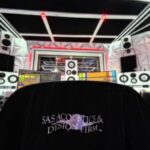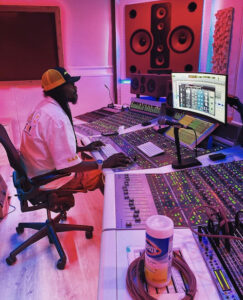Dolby Atmos has revolutionized the sound experience in theaters and studios. It provides three-dimensional immersive audio to the listeners. Despite this, Dolby installation needs to be planned carefully while designing acoustics for Dolby Atmos studios.
Dolby Atmos was initially designed for complex commercial theater systems. Currently, there is an increase in the demand for Atmos mix rooms. So we can say that conceptual sea changes are about to take place in the music industry.
Today, there are so many factors that may make it difficult for you to design and treat Dolby Atmos rooms.
In this blog, we will give detailed information about everything you require to make a Dolby Atmos requirement. We will discuss what the perfect environment for Dolby Atmos production looks like and how to do Dolby Atmos installation to ensure technical accuracy and listener satisfaction.
An Overview of Dolby Atmos:
Dolby Atmos is a technology that is object-based surround sound. It makes sound dynamic in three-dimensional space. Compared to channel-based traditional surround sound systems, Dolby Atmos uses metadata to dynamically position sound objects.
This new technology requires studio design. It supports accurate speaker placement, sound separation, and accurate acoustic response. For this, the main speaker configuration supports a minimum of 7.1.4 channels.
Dolby Atmos Studio requires one subwoofer and four overhead speakers. Controlled reflections in the room, appropriate reverberation time, and consistent frequency response are important for accurate room acoustics.
Studio Room Design:

The physical dimensions and shape of the studio play an important role in its acoustic performance. Installing Dolby Atmos according to the proportions of the room is an essential process. Parallel walls should be avoided in the installation process.
Parallel walls in a Atlanta recording studio room can cause a flutter echo. Using non-parallel surfaces or incorporating absorbent materials can reduce this problem.
Speaker Placement and Calibration:
Accurate speaker placement is extremely important for Dolby Atmos Studio. Speakers provide accurate localization of sound objects and seamless integration with overhead channels. All speakers should be equidistant from their primary listening position. This will ensure a balanced sound.
Install overhead speakers at a 45-degree angle from the listening position. This will ensure proper height and spatial imaging. Correcting speaker levels and delays using the calibration tool Room EQ Wizard or Dolby’s calibration software enhances its quality.
( Also Read More – Dolby Atmos Music Mastering )
Acoustic Treatment:
Acoustic treatment makes the sound quality of the room neutral and controlled. This process is important for accurate mixing. Various treatment strategies for this are as follows.
1. Bass Traps: First of all, place bass traps in the corners. This will manage low-frequency build-up.
2. Absorbent Material: Place broadband absorbers on the walls and ceiling. This will reduce unwanted reflections.
3. Diffuser: Use diffusers in the back of the room. This will maintain natural sound and prevent harsh reflections.
For detailed information, research about Dolby Atmos studio Georgia. This will help you understand many important factors in detail.
Sound Isolation and Noise Control:

Sound isolation prevents external noise from interfering with the mixing process. This prevents the sound produced by the studio from disturbing adjacent spaces. The most important of sound isolation is decoupled construction techniques.
It isolates the studio structure from surrounding areas using flexible channels, floating floors, and double walls. Add mass-loaded loads to walls, floors, and ceilings to prevent sound transmission. Also properly seal doors, windows, and ventilation systems.
Reverberation Time and Room Acoustics:
You should know about Reverberation time. It takes for sound in a space to decrease by 60 decibels. RT60 must be strictly controlled to control reverberation time for Dolby Atmos studios.
Recommended RT60 values include reverb times of 0.2 to 0.4 seconds for small to mid-sized studios and 0.6 seconds for larger spaces. Adjust reverb times using tools like Smaart or Dirac Live to measure them.
1. Subwoofer Integration and Bass Management:
Proper subwoofer integration is important for delivering the full spectrum of sound, especially low-frequency effects. Be sure to consider subwoofer placement and place it in the correct location. Use multiple subwoofers if necessary.
Set the crossover frequency to integrate smoothly with other speakers in Crossover Settings. Measure and correct room modes using parametric EQ in Room Calibration.
2. Lighting and Ergonomics:
Lighting and ergonomics play a vital role in a comfortable studio environment. Create non-reflective surfaces in the studio. Also, use matte finishes. This will reduce distracting light reflections during mixing.
Include dimmable lights to suit different tasks. This will enhance the quality of the studio. Give priority to ergonomic seating. This will keep the sitting in the studio comfortable.
3. HVAC and Ventilation:
Heating, ventilation, and air conditioning systems can introduce unwanted noise into the studio environment. Use silent HVAC units to address this.
Also, install various sound-absorbing material ducts. Place HVAC equipment outside the studio in an acoustically isolated enclosure. This will enhance the quality of the studio.
4. Compliance with Dolby Certification Standards:
Dolby Atmos provides specific guidelines for studio certification. It requires confirmation of compliance with Dolby’s recommended speaker positions by the speaker layout.
The acoustic testing process must also include testing for frequency response, sound pressure level, and spatial imaging. Keep detailed records of the design and calibration procedures in the documentation process. This will allow certification to be submitted in necessary situations.
Conclusion:
Designing a Dolby Atmos studio requires careful attention to acoustic and technical details. From room dimensions to speaker placement is capable of providing immersive audio experiences.
We can configure the system on the rendering computer to achieve great sound. Keep the size of the room in mind when planning your space. Choose high-quality equipment and use it with subwoofer placement. Dolby Atmos Studio Atlanta offers its audience a unique movie experience.
By following the guidelines mentioned in this article and ensuring compliance with Dolby standards, you can build a professional studio. This studio will help inspire creativity and new communications in audio production.

